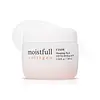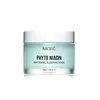What's inside
What's inside
 Key Ingredients
Key Ingredients

No key ingredients
 Benefits
Benefits

 Concerns
Concerns

 Ingredients Side-by-side
Ingredients Side-by-side

Water
Skin ConditioningHydrolyzed Collagen
EmollientButylene Glycol
HumectantAdansonia Digitata Fruit Extract
EmollientCyclopentasiloxane
EmollientAlcohol
AntimicrobialGlycerin
HumectantCyclohexasiloxane
EmollientTrehalose
HumectantAdansonia Digitata Seed Oil
EmollientDimethicone
EmollientDimethicone/Vinyl Dimethicone Crosspolymer
Skin ConditioningDimethiconol
EmollientBeta-Glucan
Skin ConditioningStearyl Behenate
EmollientGlyceryl Caprylate
EmollientAmmonium Acryloyldimethyltaurate/Vp Copolymer
Ethylhexylglycerin
Skin ConditioningInulin Lauryl Carbamate
Emulsion StabilisingCarbomer
Emulsion StabilisingPoloxamer 407
EmulsifyingPolyglyceryl-3 Methylglucose Distearate
EmulsifyingPolysorbate 20
EmulsifyingPropanediol
SolventPhytantriol
HumectantHydroxypropyl Bispalmitamide Mea
EmollientTromethamine
BufferingDisodium EDTA
Phenoxyethanol
PreservativeParfum
MaskingWater, Hydrolyzed Collagen, Butylene Glycol, Adansonia Digitata Fruit Extract, Cyclopentasiloxane, Alcohol, Glycerin, Cyclohexasiloxane, Trehalose, Adansonia Digitata Seed Oil, Dimethicone, Dimethicone/Vinyl Dimethicone Crosspolymer, Dimethiconol, Beta-Glucan, Stearyl Behenate, Glyceryl Caprylate, Ammonium Acryloyldimethyltaurate/Vp Copolymer, Ethylhexylglycerin, Inulin Lauryl Carbamate, Carbomer, Poloxamer 407, Polyglyceryl-3 Methylglucose Distearate, Polysorbate 20, Propanediol, Phytantriol, Hydroxypropyl Bispalmitamide Mea, Tromethamine, Disodium EDTA, Phenoxyethanol, Parfum
Water
Skin ConditioningButylene Glycol
HumectantNiacinamide 5%
SmoothingCyclopentasiloxane
EmollientGlycerin
Humectant1,2-Hexanediol
Skin ConditioningCyclohexasiloxane
EmollientDimethicone
EmollientAmmonium Acryloyldimethyltaurate/Vp Copolymer
Trehalose
HumectantPolyglyceryl-3 Methylglucose Distearate
EmulsifyingTromethamine
BufferingDimethicone/Vinyl Dimethicone Crosspolymer
Skin ConditioningPEG-20 Sorbitan Cocoate
EmulsifyingCarbomer
Emulsion StabilisingButyrospermum Parkii Butter
Skin ConditioningOlea Europaea Fruit Oil
MaskingCaprylic/Capric Triglyceride
MaskingSqualane
EmollientHydrogenated Lecithin
EmulsifyingDimethiconol
EmollientDisodium EDTA
Melia Azadirachta Leaf Extract
Skin ConditioningMelia Azadirachta Flower Extract
Skin ConditioningCoccinia Indica Fruit Extract
Skin ConditioningSolanum Melongena Fruit Extract
Skin ConditioningSodium Hyaluronate
HumectantAloe Barbadensis Flower Extract
EmollientEchinacea Angustifolia Leaf Extract
MoisturisingHydrolyzed Sodium Hyaluronate
Skin ConditioningHydrolyzed Hyaluronic Acid
HumectantHyaluronic Acid
HumectantRosa Damascena Flower Water
MaskingCeramide NP
Skin ConditioningCholesterol
EmollientSodium Hyaluronate Crosspolymer
HumectantHydroxypropyltrimonium Hyaluronate
Ocimum Sanctum Leaf Extract
Skin ConditioningPhytosphingosine
Skin ConditioningSodium Acetylated Hyaluronate
HumectantCurcuma Longa Root Extract
MaskingCorallina Officinalis Extract
Skin ConditioningCentella Asiatica Extract
CleansingCamellia Sinensis Leaf Extract
AntimicrobialPentylene Glycol
Skin ConditioningMadecassoside
AntioxidantHippophae Rhamnoides Fruit Extract
Skin ConditioningWater, Butylene Glycol, Niacinamide 5%, Cyclopentasiloxane, Glycerin, 1,2-Hexanediol, Cyclohexasiloxane, Dimethicone, Ammonium Acryloyldimethyltaurate/Vp Copolymer, Trehalose, Polyglyceryl-3 Methylglucose Distearate, Tromethamine, Dimethicone/Vinyl Dimethicone Crosspolymer, PEG-20 Sorbitan Cocoate, Carbomer, Butyrospermum Parkii Butter, Olea Europaea Fruit Oil, Caprylic/Capric Triglyceride, Squalane, Hydrogenated Lecithin, Dimethiconol, Disodium EDTA, Melia Azadirachta Leaf Extract, Melia Azadirachta Flower Extract, Coccinia Indica Fruit Extract, Solanum Melongena Fruit Extract, Sodium Hyaluronate, Aloe Barbadensis Flower Extract, Echinacea Angustifolia Leaf Extract, Hydrolyzed Sodium Hyaluronate, Hydrolyzed Hyaluronic Acid, Hyaluronic Acid, Rosa Damascena Flower Water, Ceramide NP, Cholesterol, Sodium Hyaluronate Crosspolymer, Hydroxypropyltrimonium Hyaluronate, Ocimum Sanctum Leaf Extract, Phytosphingosine, Sodium Acetylated Hyaluronate, Curcuma Longa Root Extract, Corallina Officinalis Extract, Centella Asiatica Extract, Camellia Sinensis Leaf Extract, Pentylene Glycol, Madecassoside, Hippophae Rhamnoides Fruit Extract
Ingredients Explained
These ingredients are found in both products.
Ingredients higher up in an ingredient list are typically present in a larger amount.
Ammonium Acryloyldimethyltaurate/Vp Copolymer (let's call it AAVC for short) is a synthetically created polymer. It's used as a film-forming agent and used to thicken the consistency of products.
AAVC is able to increase the consistency and viscosity of products due to its large molecule size. It also prevents ingredients from separating.
Butylene Glycol (or BG) is used within cosmetic products for a few different reasons:
Overall, Butylene Glycol is a safe and well-rounded ingredient that works well with other ingredients.
Though this ingredient works well with most skin types, some people with sensitive skin may experience a reaction such as allergic rashes, closed comedones, or itchiness.
Learn more about Butylene GlycolCarbomer is a polymer of acrylic acid. Its main role is to create a gel consistency.
A high amount of carbomer can cause pilling or balling up of products. Don't worry, most products contain 1% or less of carbomer.
Cyclohexasiloxane is a type of silicone more commonly known as D6. It is an emollient and solvent.
Cyclohexasiloxane is used to evenly distribute ingredients throughout the product. When applied to the skin, Cyclohexasiloxane evaporates and leaves behind a silky feel.
As an emollient, it can help the skin feel soft and hydrated. It is also used to reduce frizz in hair products.
Learn more about CyclohexasiloxaneCyclopentasiloxane, or D5, is a silicone used to improve texture of products and trap moisture.
D5 is considered lightweight and volatile. Volatile means it evaporates quickly after application. Once evaporated, D5 leaves a thin barrier that helps keep skin hydrated.
It is also an emollient. Emollients help soften the skin and prevent water loss. Silicones create a silky texture in products. D5 helps other ingredients become more spreadable.
Studies show D5 is safe to use in skincare products. We recommend speaking with a skincare professional if you have concerns.
Learn more about CyclopentasiloxaneDimethicone is a type of synthetic silicone created from natural materials such as quartz.
What it does:
Dimethicone comes in different viscosities:
Depending on the viscosity, dimethicone has different properties.
Ingredients lists don't always show which type is used, so we recommend reaching out to the brand if you have questions about the viscosity.
This ingredient is unlikely to cause irritation because it does not get absorbed into skin. However, people with silicone allergies should be careful about using this ingredient.
Note: Dimethicone may contribute to pilling. This is because it is not oil or water soluble, so pilling may occur when layered with products. When mixed with heavy oils in a formula, the outcome is also quite greasy.
Learn more about DimethiconeThis ingredient is a silicone used to improve the texture of products and absorb oil. It does not get absorbed into the skin.
Like other silicones, Dimethicone/Vinyl Dimethicone Crosspolymer helps condition the skin by creating a barrier. In this sense, it can act as an emollient and trap moisture in.
This ingredient is a type of elastomer.
Learn more about Dimethicone/Vinyl Dimethicone CrosspolymerDimethiconol is a silicone that resembles the popular dimethicone. Like other silicones, it is an emollient. Emollients create a thin film on skin to prevent moisture from escaping.
This ingredient helps to create a silky texture and improve spreadability. Due to its high molecular weight and thickness, it is often combined with cyclopentasiloxane.
Disodium EDTA plays a role in making products more stable by aiding other preservatives.
It is a chelating agent, meaning it neutralizes metal ions that may be found in a product.
Disodium EDTA is a salt of edetic acid and is found to be safe in cosmetic ingredients.
Learn more about Disodium EDTAGlycerin is already naturally found in your skin. It helps moisturize and protect your skin.
A study from 2016 found glycerin to be more effective as a humectant than AHAs and hyaluronic acid.
As a humectant, it helps the skin stay hydrated by pulling moisture to your skin. The low molecular weight of glycerin allows it to pull moisture into the deeper layers of your skin.
Hydrated skin improves your skin barrier; Your skin barrier helps protect against irritants and bacteria.
Glycerin has also been found to have antimicrobial and antiviral properties. Due to these properties, glycerin is often used in wound and burn treatments.
In cosmetics, glycerin is usually derived from plants such as soybean or palm. However, it can also be sourced from animals, such as tallow or animal fat.
This ingredient is organic, colorless, odorless, and non-toxic.
Glycerin is the name for this ingredient in American English. British English uses Glycerol/Glycerine.
Learn more about GlycerinPolyglyceryl-3 Methylglucose Distearate is created from the diester of stearic acid and the condensation product of methylglucose and Polyglycerin-3.
As an emulsifier, it is used to bind ingredients together. Many ingredients, such as oils and water, separate naturally. Emulsifiers prevent them from separating to ensure even consistency in texture.
One of the manufacturer for this ingredient states it is vegetable-based. It is also claimed to be stable at both high and low temperatures.
This ingredient may not be safe for fungal acne. We recommend speaking with a professional if you have any concerns.
Learn more about Polyglyceryl-3 Methylglucose DistearateTrehalose is a disaccharide made of two glucose molecules (glucose is sugar!). Trehalose is used to help moisturize skin. It also has antioxidant properties.
As a humectant, trehalose helps draw moisture from the air to your skin. This helps keep your skin hydrated.
Due to its antioxidant properties, trehalose may help with signs of aging. Antioxidants help fight free-radical molecules, unstable molecules that may damage your skin.
In medicine, trehalose and hyaluronic acid are used to help treat dry eyes.
Some animals, plants, and bacteria create trehalose as a source of energy to survive freeze or lack of water.
Learn more about TrehaloseTromethamine helps balance the pH and improve the texture of a product. It is synthetically created.
As an emulsifier, Tromethamine prevents oil and water ingredients from separating. This helps stabilize the product and elongate a product's shelf life. Tromethamine also makes a product thicker.
Tromethamine helps balance the pH level of a product. Normal pH level of skin is slightly acidic (~4.75-5.5). The acidity of our skin is maintained by our glands and skin biome. Being slightly acidic allows our skin to create an "acid mantle". This acid mantle is a thin barrier that protects our skin from bacteria and contaminants.
Oral Tromethanmine is an anti-inflammatory drug but plays the role of masking, adding fragrance, and/or balancing pH in skincare.
1,3-Propanediol, 2-amino-2-(hydroxymethyl)-
Learn more about TromethamineWater. It's the most common cosmetic ingredient of all. You'll usually see it at the top of ingredient lists, meaning that it makes up the largest part of the product.
So why is it so popular? Water most often acts as a solvent - this means that it helps dissolve other ingredients into the formulation.
You'll also recognize water as that liquid we all need to stay alive. If you see this, drink a glass of water. Stay hydrated!
Learn more about Water